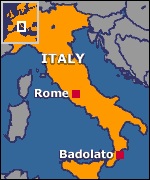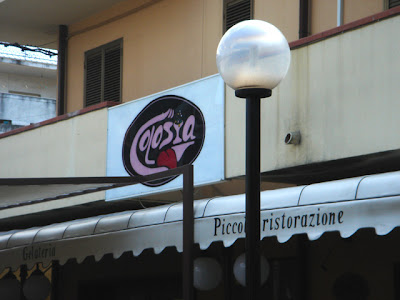Archive for the ‘life in calabria’ Category
Badolato: Into The Heart of Calabria
Badolato Basics
My village, the birthplace of my great-great-grandfather, is Badolato, and it’s located between the Ionian Sea and the Serre Mountains in Calabria, the toe of Italy’s boot.
Badolato, the meaning of which is in dispute (sorry, only in Italian) was founded in 1080 by conqueror and first Duke of Calabria Robert Guiscard, who along with his brother, took over southern Italy and Sicily for the Normans around that time.
Like many villages of this period, Badolato was built on a hilltop about 5 kilometers from the sea with a good view of any approaching ships. Staying too close to the water was considered dangerous not only because of potential invasion–the southernmost part of the peninsula was the gateway to the entire territory now known as Italy and the rest of Europe–but also because of malaria, which was quite common as some of the area was swampland.
View of Badolato Superiore from the winding road leading up to the village.
And so, Badolato was built as a walled city, encircled by stone and guarded by three watchtowers, one of which is still partially standing (below); the town crest honors these watchtowers and the village’s medieval history.
Many of the original walls around the village as well as the old gates that sealed off the city from invaders also remain, but a castle on a hill that was once the town’s centerpiece (thus the name of the main square Piazza Castello) had to be torn down in the 1970s for safety reasons. Previously, it had cast a shadow on all that was below it, as castles are wont to do.
The piazza is now alternately called Piazza Fosso—fosso referring to the huge hole left behind by removing the hill and castle (it didn’t create a hole really, only leveled off the hill the castle had been on).
Political, social, and agricultural history
As rulers changed throughout southern Italy (German, French, Spanish, Turk, Austrian, Bourbon) Badolato felt each influence in turn, which you can hear in Badolatese, the main tongue spoken around here (a version of the Calabrian/Sicilian language, which some (mistakenly) call a dialect), and taste in the traditional Calabrian cuisine, noted for its fondness for the peperoncino, brought back to Italy by Columbus, although also widely used by Arabs who settled here.
Badolato soon became one of the most prominent and wealthiest cities in what is now southern Italy, swelling to a population of 8,000 (some estimates say up to 12,000) and boasting the palazzi of some of the most influential families in southern Europe, mostly due to production of olive oil, wine, and citrus fruit.
The family of the former baron of Badolato still owns a palazzo or two (although they don’t live here full-time) as well as a grand villa that sits on a huge chunk of the land surrounding the village. Almost all of the land around Badolato is still farmed, including that of the former baron, but most of it is was broken into smaller plots as the feudal system died down around the turn of the 20th century.
Incidentally, on the bigger plots, some families built workhouses (no plumbing, electricity, etc.), but still today it is rare for Calabrians to consider actually living on that kind of open land (most prefer village life and traveling by car or by foot to their land). Indeed getting permits to build is difficult as the land is zoned agricultural. Unless it has some existing structure (at least the remains of a wall!), it’s illegal to build a house on these land plots–which means no subdivisions in Calabria’s future. No complaints here.
Religious heritage
Badolato’s importance and deep religious and spiritual history are represented by its 13 churches and 17th century Convento Santa Maria degli Angeli, once a monastery but now a drug and alcohol rehabilitation treatment center; residents produce their own food on site and even operate a restaurant.
Convento nestled among olive trees
(You may remember this old monastery from the Easter procession)
Some say that it’s possible that the Holy Grail was transported here and may still be buried underground somewhere. In 1070, a group of Calabrian monks went to France and established the Ordre de Sion, which later became the Priory of Sion of Dan Brown’s Da Vinci Code fame–said to be the keepers of the Grail. The Calabrian monks returned to Calabria in 1090 but no one knows what, if anything, they brought with them from France; could they have incorporated valuable Christian artifacts into the underground ducts and tunnels of a blossoming Catholic stronghold called Badolato?
Effects of emigration
Like many southern Italian towns, Badolato was a victim of emigration, largely abandoned during two major waves of flight: the first in the early twentieth century (when my family left) and the second after World War II.
In both instances, emigrants were looking for better opportunities, but especially after the second World War when southern Italy was truly war-torn and downtrodden; my 82-year-old neighbor has sung for me a children’s rhyme that complained to Il Duce, Benito Mussolini, that they were living the day without bread and the night without lights (u jornu senza pane, la notte senza luce). A flash flood that wiped out a part of the village in the 1950s surely made the decision to leave easier for many.
Badolatesi fled to, among other places, the United States, Canada, Argentina, Brazil, Germany, Switzerland, and Australia, many leaving behind their homes with only whatever they could carry, never to return.
Others moved just down to the coast, where Badolato Marina was being built in the 1950s–living nearer to the water was now considered safe, plus coastal life was also more convenient with the railroad and highway running through there.
Indeed, P’s mom remembers where there wasn’t even a paved road leading down from the mountain village to the sea–I’ve yet to walk the path, but it’s still there–and anyway, there were only a handful of cars in the village even in to the 1960s, so you can that imagine folks tended to stay close to home.
Because of this mass emigration, the population of Badolato Superiore now stands at about 350 (total population with Badolato Marina is around 4000). This set-up is quite common throughout southern Italy, by the way, so that you’ll often see a “Superiore” town up on the hill/mountain, and its counterpart closer to the sea with “Marina” or “Lido” after the name.
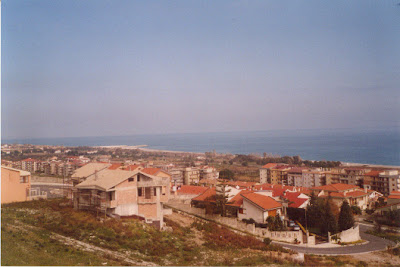 Badolato Marina
Badolato Marina
(Sorry for the poor quality here; it’s an old scanned photo of mine)
The Ship of Kurds
Badolato had fleeting hope of a boom just after Christmas 1997 when 825 Kurdish refugees landed on its shores; this made international news and you can read more about it here (the man on the left in the third photo is my vicino Giuseppe!).
The Badolato community welcomed the Kurds as potential workers and young revitalizers of the old town. The new immigrants are mostly gone now, though, either deported or having left for Germany, France, or elsewhere in the EU for work.
Still, Badolato remains one of the most involved immigration centers in all of Italy in so far as welcoming migrants and helping them with housing, health care, work, and psychological adjustment to life in a new country; one of my translation contracts with the local health care agency involves a special EU project to include cultural and linguistic mediators in this process.
Current and Future Badolato
And yet Badolato remains largely empty, like the village Farfallina wrote about, although the population swells enormously in August when many return to their hometown from Germany, northern Italy, etc., for ferie–Calabria, generally, is quite a hot spot for Italians and other Europeans looking for great, clean beaches.
Even the New York Times agrees.
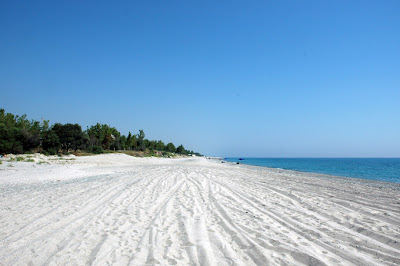 Photo © Franco Muìa
Photo © Franco Muìa
Badolato is undergoing a revitalization, though, as there have already been quite a few properties sold to international buyers over the years; casa by casa things are looking more lived in, although I’m the only year-round foreigner who lives here (Badolatesi would say the transplants from Genoa, Naples, and elsewhere in Italy are also stranieri, but I’m the only non-native Italian).
There is a lot of potential here for tourism, as you can probably imagine, although there would need to be a lot of infrastructure work done first–getting here and getting around isn’t always easy. No one wants to commercialize the town to the point that it’s another Siena or Cortona, overrun with tourists, but a few more visitors, a few more people who want to experience the real Italy complete with women carrying baskets on their heads?
Well that would be nice.
We may not have much support from the government, but we do have green mountains, a clear blue sea, fresh mountain air and water, warm souls, and delicious, fresh food, and for me, that’s certainly plenty.
Final Notes
For those of you who have made it this far (thank you!) and still want more, you can see more photos under the Scenes from Village Life label, my first Virtual Tour, and the two most recent posts: Destination Calabria: Photo Tour of a Medieval Village (Part I) and (Part II).
And if you want to plan a trip, just let me know!
destination calabria:photo tour of a medieval village (part II)
We left off yesterday with a glance back at one of the abandoned parts of my village, and now it’s time to delve even deeper.
Here’s where we were.
This is one of the original walls of the village that used to protect from invasions of pirates and the like.
And here’s another angle of the same wall, which you can tell from the flowers growing out of it (remember, this was May when the photos were taken).
The big crack down the middle? Earthquake damage from at least the 1950s, but probably before then even as this area has been hit with quite a few big ones–the city of Reggio Calabria was leveled in 1908.
The village was also the victim of an alluvione, a flash flood that caused a mudslide, wiping off a good chunk of the village–that’s the part we’ve been walking through, and now we’re in a section that, although didn’t wash away, was where a lot of those houses landed.
The village is situated up on a hill, which means a lot of steep inclines and declines, right Cherrye? This is a small one:
And although this entire section of the village is completely abandoned, there are still some chickens, pigs, goats, etc., kept down here. And other stuff.
If you keep walking, you’ll eventually get to the lowest church in the village, Chiesa della Provvidenza, built in 1598, which puts her in the younger half of the thirteen churches in the village.
She’s also one of my favorites because the town celebrates la Madonna di Provvidenza on the first Sunday in July–which means that every year, there’s a cook-out and fireworks at least sometime around the 4th of July, which is nice for this American.
Plus the church kind of reminds me of a gingerbread house, and they always make me smile.
On the left side of the above photo, do you see the small wooden cross that looks like it was built to face the church? I couldn’t resist taking a closer look.
I’m not sure if there is any special significance, but I do know that there was a tragic accident near there many years ago involving young children playing with explosives they found; as legend goes, after World War II, many soldiers literally dropped their weapons and ammunition where they were standing when they heard the war was over, and every now and again, there is word of someone finding something from that time period.
P tells me there were some explosives that resembled sardine cans with a peel-back lid, so one could see how children might get curious.
And this is where Luna lost all patience and ran off towards home without me. Photo tour cut short on that lovely Sunday morning in May.
I hope to take another one soon, though, and I’ll be sure to share what I see.
On yesterday’s post, there were a few questions in the comments regarding the state of the village, how it got this way, what’s happening now, etc., and I promise to answer them all in due time. It’ll require preparing a short yet interesting history lesson, which I promise to work on over the weekend if you promise to come back to learn.
Would it help if I guarantee a mention of the Holy Grail?
—————
[tags]calabria, medieval villages, southern italy, badolato[/tags]
destination calabria:photo tour of a medieval village in southern italy (part I)
It’s been a while since I’ve posted some photos, and I think it’s time. I’m still camera-less, but I do have some shots stored away, so let’s go back to a lovely day in May when Luna and I took a walking tour around a section of the village.
It all started out in the little piazza near my house where the main church is located; truth be told, I hadn’t even brought my camera but then I saw these:
So I went back home and grabbed the macchina fotografica. I don’t know how these roses ended up there, but it’s certainly not uncommon to find flowers outside the church in the morning.
By the way, we have 13 churches here in all (reminder: 300 people), but only one operates full time. I promise to write more about the history of the village at some point and how it’s been largely abandoned (inspired by Farfallina!) but until I can get more photos to accompany it, we’ll just have to stick with what I’ve got.
Here’s the bell tower of La Chiesa Matrice/La Chiesa di San Salvatore, built in 1218.
After we wound down one of the winding streets, I saw this cactus giving a helping hand to a piece of fallen fruit:
The fruit is a fico d’india (Indian fig) aka prickly pear. I’m not quite sure why the one in the grip of the cactus is ripe when none of the others are–and actually I’m not sure why that one is ripe at all.
Remember this was May, and their season is now (sorry I can’t get a good photo for you Gil, but do check out Sara’s post!), so that coddled one sure was special.
Moving on. . . .
Sorry, but there’s really nothing else behind there except this:
No one (human) lives in this part of the village, and so much of it is falling down, boarded up, and otherwise abandoned-looking.
Here is my very favorite abandoned house.
If you peek in through the crack in the front door, you can see la famiglia gathered inside the small room on the first chilly night of the year:
La Mamma stirring the sugo one last time before getting the water ready for pasta, resting the wooden spoon on the side of the terra cotta pot, and wiping her hands on her well-worn but clean apron.
La figlia embroidering sheets in preparation of her upcoming matrimonio, pulling the thread up through the fabric and back down, over and over, her feet resting on the old braciere.
Il figliolo and Papà playing briscola in another corner, their many layers of clothes making each throw of a card less dramatic than it normally would be.
[I may or may not have spent many hours sitting near this house over the past four years.]
But back to 2007, and back to greenery, which is just around the corner.
Can you find Luna?
And finally, a quick glance back at where we’ve been before we move on.
Won’t you come back and continue our passeggiata?
—————
[tags]calabria, southern italy, badolato, medieval villages, dogs[/tags]
my italian vacation (sort of) and your summer homework
Taking a cue from fellow Italy expat bloggers Shelley, Sara, Jessica, and Sara, I’m taking a little time off away from the blog.
I know this is odd for those of you in America, especially, to wrap your heads around, but here in Italy, just about everyone takes most if not all of August off. P and I aren’t going anywhere since everyone comes to us (ah, living in southern Europe is so tough!), and in fact, we’re both still working.
But we’ll also be spending plenty of time with his 6 brothers and sisters and 16 (or is it 17?) nieces and nephews that are here right now, so I’m taking a break from posting for a little while.
I’ll still be around visiting your blogs, though (can’t keep me away if you tried!) and I may even pop in to say hello here, but while I’m gone I have some suggestions to keep you busy:
1. Head over to The Island Review, a great site for keeping up with all the contests and give-aways going on via the Internet, including a fabulous contest for digital camera loversthrough PicaJet–you can win a PicaJet FX and/or RoboImport!
What’s all that you say? It’s about making our digital photos the best they can be and also keeping them organized, so do click on the above links for more information. Hurry, ends August 15th!
FYI, the author, Kailani, is a dedicated mom, wife, and flight attendant who also writes An Island Life from her home base in Hawai’i. I know. I’d hate her too if she wasn’t so damn sweet.
2. I’ve told you about the group She Who Blogs before, and now I’m going to send you to one of our most recent members’ blogs: Model Behavior.
You should visit all the member blogs as they’re all wonderful (seriously!), but when I clicked on this one, I wanted to read every post from the beginning. I think we all know that’s a rare warm fuzzy in the blogosphere, so I wanted to pass it on to you.
3. Another of my recent discoveries is The Passionate Palate, and for those of you who enjoy a great food blog, this one is for you.
Jeni, the author, also runs Passionate Palate Tours, food and wine tours through Italy, and I’ve had great fun corresponding with her the past few days. Give her some comment and link love!
4. Check out a great post on work and life balance over at Writing, Work and Weasels, and for those of you who can read Italian, go read Audrissima’s L’onestà, la bellezza nella semplicità e l’amore–and why not comment and tell them I sent you?
These are my favorite posts of the day so far, but the day is young, bloggers, so get writing!
I really *should* start posting my favorite posts every day…hmm…hello Google Reader? Something for me to think about over the break (while I am reading many, many books).
5. Spread the word about my Bella Bags E-Party and Contest on your own blog, then come back here and tell me (or email me) and I’ll send you special link love when I return.
Woohoo! We’re all winners!
There are so many more recommendations I have for you, and that’s what I’ll spend part of my vacation compiling, I promise.
See, I’ll be thinking of you, so that makes it OK, right?
Here’s your postcard in advance:
Hope all your days feel like this.
—————
[tags]ionian sea, sea, montepaone, calabria, southern italy[/tags]
Tour del Gelato: Golosia in Gioiosa Ionica Marina, Calabria
 Here is, finally, my first contribution to the Tour del Gelato, brainchild of Sara of Ms. Adventures in Italy–and from what I’ve been reading in the blogosphere, my timing isn’t too bad as it seems many of you in the US could use a touch of relief.
Here is, finally, my first contribution to the Tour del Gelato, brainchild of Sara of Ms. Adventures in Italy–and from what I’ve been reading in the blogosphere, my timing isn’t too bad as it seems many of you in the US could use a touch of relief.
To my readers enjoying cooler weather, I’m jealous, but at least I have gelato!
Today’s destination today is actually a place I’ve mentioned in a previous post (Eating Out in Calabria), and it remains my favorite gelateria (place where they make gelato, of course) around here.
It’s appropriately called “Golosia,” which means something along the lines of gluttony or greed in Italian, and it’s been holding down a well-trafficked corner of the SS 106 (Calabria’s version of California’s Pacific Coast Highway) in Gioiosa Ionica Marina since 1989.
There are 32 different flavors in the gelateria section, but they also make cakes, pastries, cannoli, and torrone di mandorle–an almond nougat that’s shipped all over Europe and even to America. Their concoctions have been honored in various prestigious events throughout Italy, including the famous EuroChocolate in Perugia (ooh, which I now see will be held on and around my birthday this year…hmm…).
Golosia also operates as a restaurant, and the place itself is rather large with seating for 60 inside and another 300 outside–some nights there’s even a piano bar.
Right, but you want to see the gelato, right?

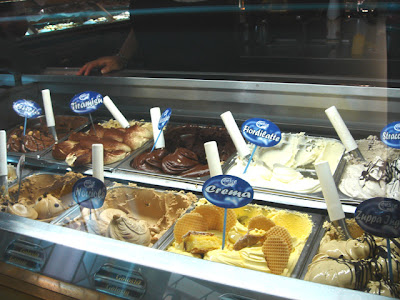 See those wafers in the “crema” flavor? They stick one of those in every cup or cone (two if you ask nicely). Pretty!
See those wafers in the “crema” flavor? They stick one of those in every cup or cone (two if you ask nicely). Pretty!
Now, as you might know, I’m currently cameraless, so these shots were taken with my friend Carla’s camera–which had precisely 15 minutes of battery life left even though we were heading to a fun event (report coming soon!); needless to say, I had to snap quickly and then close the camera, snap and close, snap and close. So these aren’t the greatest photos, but I think you get the idea.
Since Carla was dolce enough to give me free reign with her camera during our adventure, I promised her a spot on the blog. Here she is enjoying a banana cone, which I highly recommend as the banana flavor is *so* good. All their fruit flavors are made with fresh fruit, of course, so there’s no weird artificial, medicinal banana flavoring going on here.
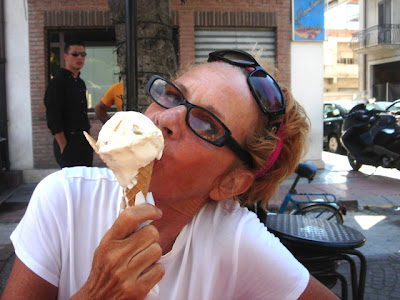 I’m sure the guy in the background only thought I was a *little* weird for snapping and closing repeatedly.
I’m sure the guy in the background only thought I was a *little* weird for snapping and closing repeatedly.
This visit I had a small cup of pistacchio (my staple) and “bacio.” For those who don’t know, bacio means kiss in Italian, but in the chocolate world, it’s a small candy made by Perugina with a hazelnut inside. That description is pathetic for just how good they are, but it’ll have to do until you can try one.
Anyway, the “bacio” gelato is made with them and, whoa, is it chocolatey. And delicious. Especially with pistacchio. Yum.
So next time you’re in Calabria and looking for a great gelato, head to:
Golosia
Piazza Zaleuco
Gioiosa Ionica Marina (RC)
Italy

